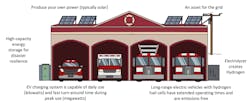Station Design: Economizing the Firehouse that Runs Electric Rigs
In 2016, I ordered an electric car as part of my fire chief retirement plan. It occurred to me that electric fire apparatus would follow soon. The advantages of electric rigs—safety, efficiency, lower cost and lower emissions—meant that they eventually would be preferred over diesel and gasoline versions.
Then I thought about the risks of using an electric vehicle (EV) in a mission-critical application. I don’t mean the risks of battery fires; I mean the risks of operational failure. How will we build a charging infrastructure at the firehouse that’s powerful enough and resilient enough to support mission-critical EVs?
One answer is to put a large battery on the fire station itself, charge the battery by using solar panels on the roof and design the system to work when the power is out. Such a system is called a microgrid, because it resembles a miniature version of an electrical grid.
Economics
Microgrids have the potential to power a critical facility, including a fire station, independently for an indefinite amount of time. Some communities already added them to their fire stations and other critical facilities, given energy insecurity because of our aging electrical grid. Microgrids already power fire stations in Charlotte, NC, and Puerto Rico. However, those microgrids don’t include a robust EV charging system.
Departments that have EVs, such as Madison, WI, Los Angeles and Mesa, AZ, had to install expensive, 480-volt, three-phase power systems to charge their EVs if the station that houses an EV didn’t have that level of power already. Backup generators also work, but they are a cost, not an investment. A microgrid is a more economical option. It produces power, so it provides value from the moment that it’s turned on, which makes it a good investment. Energy costs are offset. When a microgrid is designed in conjunction with a local electric utility, the grid operator will use the station’s energy storage system for demand response and load balancing. As a result, the microgrid pays for itself. Furthermore, residents and businesses that are located in the vicinity of the station have better power quality.
Funding option
Montgomery County, MD, developed a microgrid financing system in 2016 that uses a power purchasing agreement (PPA). A PPA calls for a municipality to contract with private investors to design, build and pay for a microgrid in exchange for buying the electricity that the microgrid produces. This public-private partnership funds resilient energy infrastructure improvements for the municipality and gives a return on investment to the financier. This model is referred to as Energy as a Service (EaaS).
A department must work with an energy professional before its first EV arrives, to determine what size and type of microgrid is required and how to make the microgrid work for the station and the community.
Multiple benefits
An electric fire vehicle soon might be the better choice for many departments. Those same departments will experience a natural or human-made disaster, and power will go out. A microgrid ensures that a fire EV always is ready to respond. In addition, the resiliency of the community improves, which in turn improves people’s lives. Now is the time for departments to plan for an all-electric future.
About the Author

Michael Benson
Michael Benson is a consultant who leverages an award-winning 30-year career in public service, including innovations that simultaneously improve service and lower costs. His primary focus is switching away from fossil fuel-powered tools, equipment and vehicles to electric and developing the infrastructure (microgrids) to support that transition. Benson served as a volunteer and career firefighter, paramedic and fire officer, with his last 11 years as the fire chief for the Copley Township Fire Department in Summit County, OH. He has a professional certificate in energy innovation and emerging technologies from Stanford University, a master's degree in public administration from Anna Maria College, and a bachelor's degree and an associate degree in fire and safety engineering technology and fire science from the University of Cincinnati. Benson is a graduate of the National Fire Academy’s Executive Fire Officer Program and is an instructor for the University of Akron, with a current focus on chief officer training and mentoring. He is a board member for Green Energy Ohio and Drive Electric Northeast Ohio and a member of the Critical Services Microgrid Group in Asheville, NC.
